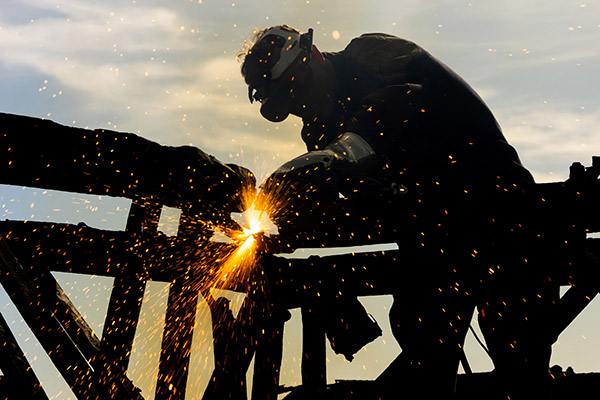By Lisa Cooley, LEED AP, M.SAME, and Chris Gaudreau
For the last three years, the construction industry has been adjusting to the lingering effects of the coronavirus. And while it is tempting to imagine settling back into pre-pandemic patterns, the reality is that the global construction landscape has been reshaped altogether.
This is not the first significant disturbance in the global construction industry. Each past disruption has left a mark on industry practices. That understanding can lend helpful insights into where the sector is headed and how to navigate the unsteady market.

Photo courtesy Gordian
DUELING FORCES AT PLAY
Before COVID had even spread to western borders in 2020, it was upending manufacturing in East Asia. Factories and plants shut down quickly as the virus spread through the region. The price for exiting stock rose sharply and, as that stock sold off, delivery times for new batches were pushed out too far to suit near-term projects.
Those international supply chain disruptions led to an increased focus on domestically produced materials and components. However, American manufacturers and suppliers also were sidelined. Labor shortages and shipping issues led to severe spikes in American-produced materials.
As infection rates began to drop and material prices slowly deflated, international conflicts started to stir. Russian aggressions toward Ukraine sparked international concerns about cybersecurity and oil supply. Subsequent cutting of oil to greater Europe pushed fuel prices up once again and accelerated inflationary forces.
Legislation helped jumpstart construction spending and push unemployment rates down. The combination of increased spending and productivity set prices for many materials on a decline, though continued inflation negated some of that regained purchasing power.
ADAPTING TO THE MARKET
Construction professionals have ridden this wave of change firsthand. Through material scarcities, labor rate volatility, equipment shortages, fuel price hikes, and the decreased purchasing power of the dollar, they have had to adapt practices to account for seemingly continuous shifts in the market.
Those adaptations are beginning to solidify into standard best practices, with three in particular bound to become staples as companies navigate the future of the construction industry: shared risk contract methods; more responsive data sources; and secure technology platforms.
Shared risk contract methods. Because the market has remained unsteady, contractors have pushed for contract inclusions that account for changes in costs, such as clauses for economic price adjustment (EPA). However, even with EPAs included, government owners may still see a lack of bids on traditional contracts. To counteract this, agencies are increasingly leaning toward contracts that mitigate risk for all parties such as early contractor involvement and collaborative design phases, like design-build or certain IDIQs.
Another innovation is the use of prices-include-variation-over-time contracts, which allow for the award price of a project to increase according to a pre-determined methodology once certain time thresholds are passed. While still experimental, this government-driven initiative in shared risk could be improved through using independent market data to adjust award price in alignment with material- and division-specific cost movement.
There also is a “sweet spot” in the utilization of cost updates. While the most accurate current and historic cost data is always a helpful resource in understanding market volatility and its impacts, there is still a need for reasonable shared risk. Budgets and contract amounts must be locked in at a certain point so the team is not chasing a constantly moving target. For some applications of cost data (such as calculating plant replacement value), temporary swings in a volatile market may drive wide variation year-over-year that make consistent budgeting for facility investments difficult.
More responsive data sources. Faster, more responsive data sources are needed to keep up with changing material prices. More up-to-date data references that respond quickly will enable better, more dynamic decision-making.
Government owners will need to look beyond internal data sources and explore reputable commercial data products. Commercial solutions produced by companies dedicated to data fidelity will deliver more timely cost data updates. Additionally, the burgeoning capabilities of machine learning and predictive modeling will enable those companies to offer better insight and foresight into murky market conditions to enhance project planning.
Secure technology platforms. Keeping track of volatile costs requires cloud enablement for automated updates. But simply migrating to a cloud-based platform is not always an option for government work. With cybersecurity growing in urgency, cloud systems used for federal projects should be hardened against outside threats.
By choosing cloud solutions that meet National Institute of Standards & Technology and FedRAMP requirements, users can ensure that sensitive data on location and costs are secure.
TRACKING VOLATILITY

The effects of the forces and reactions driving cost volatility over the last few years can be observed in the trends of material prices and lend clarity to what otherwise might seem like erratic fluctuations. As a near-ubiquitous material in construction, framing lumber prices provide a good example of this phenomenon.
From 2014 through 2018, design professionals and contractors enjoyed relative price stability. But the years since have been a different story entirely. Through the first half of 2019, the price of framing lumber looked to be on a downward trend, following the standard laws of supply and demand. But as COVID-19 hit America, many companies in the lumber industry slowed or stopped production due to lockdowns, health concerns, and economic caution.
The early days of the pandemic created a shift in consumer spending. Simultaneously, the housing market heated up due to low interest rates and remote job opportunities. All of this caused a dramatic and prolonged spike in lumber costs, which persisted into 2021 when the increased demand and low supply raised the price of lumber. Supply chain issues and labor shortages exacerbated the price surge, with costs skyrocketing more than 200 percent above pre-pandemic levels.
As the calendar flipped, the pandemic’s grip loosened, and steep interest rate increases cooled the housing market. Restrictions on travel and businesses across the country faded, and it looked as if lumber prices would drop back to near-2018 rates. But inflation and fuel costs ramped up in early 2022, the purchasing power of each dollar fell, and lumber jumped back up to record highs before resuming its decline as anti-inflationary measures were taken.
Framing lumber costs are now down 51 percent from early 2022. But the extreme quarter-to-quarter shifts in prices over the last several years since 2018 caution against expecting that decline to continue.
ADAPTING TO CHANGE
Utilizing these best practices and looking to enhance their capabilities will help A/E/C professionals and government users more effectively move into the future of the construction industry.
While no one knows exactly what the future holds, these practices will provide a solid foundation for adjusting to new developments, and adapting as they evolve—benefiting owners and contractors.
Lisa Cooley, LEED AP, M.SAME, is Vice President, Federal Solutions, and Chris Gaudreau is Chief Product Officer & Chief Technology Officer, Gordian. They can be reached at l.cooley@gordian.com; and c.gaudreau@gordian.com.
More News from TME
-

Reversing the Shrinking Industrial Base
Incentivizing companies to remain as advanced small businesses, without needing to transition to the large fully open competition market, coupled with difficulties for new small businesses to enter federal acquisition, has resulted in a steady pattern of decline in the nation’s defense industrial base, carrying with it risks to innovation, global standing, and national security. -

Fulfilling the Mission
Rear Adm. Dean VanderLey, CEC, USN, Commander, Naval Facilities Engineering Systems Command, sits down with TME to discuss the Department of the Navy’s Systems Command for shore facilities and expeditionary equipment, Naval Facilities Engineering Systems Command (NAVFAC) and its varied responsibility that directly support warfighter lethality. -

A Roadmap for Clean Energy on Kwajalein Atoll
A recent effort led by U.S. Army Space & Missile Defense Command to meet the Army Climate Strategy for operations on Kwajalein Atoll studied potential courses of action that would help the remote installation reach 100 percent carbon-pollution free electricity by 2030.